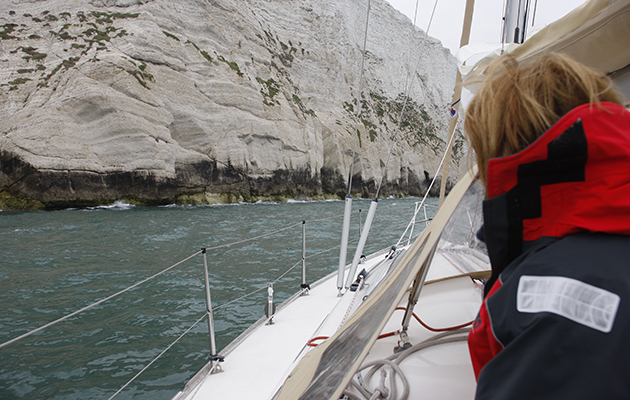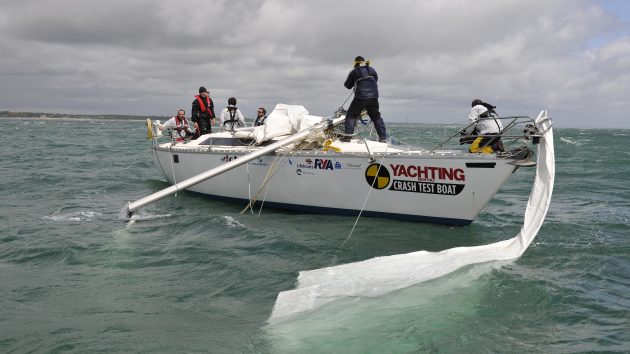What action would you take if your yacht dismasted in a tidal race? James Stevens answers your seamanship questions
Dismasted in a tidal race. What would you do?
James Stevens answers your seamanship questions
Question:
Mike is on a coastal passage from Weymouth to Dartmouth.
His boat is Antares, a 10-meter cruising yacht with three crew members. The wind is westerly Force 4.
Mike elected to take the coastal passage around the main obstacle to navigation, Portland Bill.
The waters off Portland Bill are notoriously choppy and treacherous with seven knot tidal races at the sources, but today Mike reckons the calmer waters near the coast will be navigable if it comes shortly after the current has turned in his favor.
Antares has a stepped mast with masthead rig, furling headsail, backstay, cap shrouds and lower shrouds.
The halyards and the kicker are brought back to the jammers and winches in the cockpit.
Continued below…
Crashing waves and hidden rocks have earned some British tidal races a fearsome reputation. Dag Pike explains how to navigate…

If your ship was about to board, what would you do? James Stevens answers your seamanship questions

What does boat insurance cover and why do boat owners need it? Mike Taylor reveals what’s behind the expense

James Stevens answers your seamanship questions – this month can you help another crew in distress?
Arriving at the Bill, the sea state is rougher and the wind force is stronger than Mike had expected, sailing close to the wind is almost impossible.
Perhaps most concerning is that Mike let the yacht drift out to sea in the race.
There is a loud creak; for a moment the crew are slightly stunned, then realize that almost all the rigging is off to the side.
The problem seems to be that the lower shroud on the windward side has failed, the mast has broken in the middle under the spreader and the rig is held together by the rest of the standing and running rigging.
The broken and jagged end of the mast is already damaging the gel coat on top as the yacht pitches and rolls. What should Mike do now?
To respond:
The first priority is to prevent the serrated end of the mast from punching a hole in the superstructures. There are two ways to do this.
Traditionally the rig is cut with powerful bolt cutters which few pleasure yachts carry. A hacksaw would take too long.

James Stevens, author of the Yachtmaster Handbook, spent 10 years as RYA’s Yachtmaster Training Manager and Chief Examiner
The other solution requires some sort of fendering and securing the mast to the boat with the remaining rigging or warps.
If Mike is unable to do either of these actions quickly, the yacht is in grave and imminent danger and a distress call with a cell phone or VHF radio is warranted.
The engine is unusable with so many lines in the water. My opinion is that it is better to try to save the platform.
Cutting a lot of ropes and cables, including a forestay with a foil, can be a tough job even with the right tools.
With a little coordination and once the current has taken the yacht out of the race, it should be possible to loop the spars onto the toerail.
Moreover, if the platform is kept, part of it can be reused, which is, of course, more environmentally friendly.
Once the rig is secure and a check has been made for all lines in the water, the engine can be started and Mike can aim for port with a rigger.
Most homeowners realize how expensive and dangerous a rig failure can be, as do surveyors and insurance companies.
I enjoyed reading Dismasted in a Tidal Race. What would you do?
A subscription to Yachting Monthly magazine costs about 40% less than the cover price.
Print and digital editions are available through Magazines Direct – where you can also find the latest offers.
YM is packed with information to help you get the most out of your time on the water.
-
-
- Take your seamanship to the next level with tips, advice and skills from our experts
- Unbiased in-depth reviews of the latest yachts and equipment
- Cruising guides to help you reach those dream destinations
-
follow us on Facebook, Twitter and Instagram.

